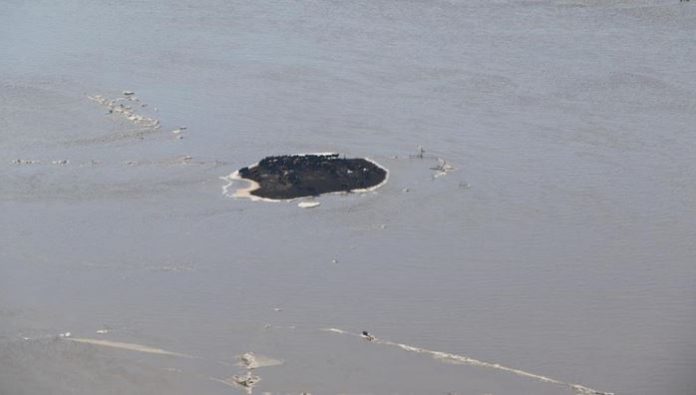
EVANSVILLE, Ind., April 11 (UPI) — Nebraska ranchers and state officials are scrambling to clear away an untold number of dead cattle that either froze in the March blizzard or drowned in the subsequent flooding.
Between the two catastrophic weather events, thousands of cattle likely perished, officials said. Many were carried away in fast-moving flood waters, leaving their carcasses strewn across the Nebraska countryside.
“Farmers are supposed to [dispose of their animals], but they don’t know where all their cows are,” said John Hansen, the president of the Nebraska Farmers Union. “And there are folks down river who have dead cows on their property that aren’t theirs. So, it’s awful.”
State officials are unwilling to speculate how many livestock were killed, but ranchers across the state reported losing large portions or, in some cases, entire herds. And the losses were compounded because the weather hit at the height of calving season — killing many newborn animals.
“It was bad, it was really bad,” said Sharon Henderson, with Platte Valley Pet Food, a Nebraska company the hauls away deceased livestock to be rendered into usable animal fat.
“At some of these places, the losses were so great we couldn’t even get it all in one day,” Henderson said. “We kept having to go back and back and back. The ranchers kept asking, ‘Are we done yet?’ And then they’d find more.”
The clean-up is far from complete. As the flood waters recede, farmers continue to discover more carcasses. Some, they are able to remove. Others remain unreachable due to flooded ground or washed-out roads.
The large number of decomposing farm animals has Nebraska state officials concerned about possible impacts to the environmental and public health, said David Halderman, the Nebraska Department of Environmental Quality’s Land Management Division manager.
Decomposing animals release large amounts of phosphorus and nitrates that can contaminate ground and surface water. They also attract other scavenger animals, some of which carry diseases that are transmittable to humans.
So, while ranchers continue to remove animals from their own properties, several government agencies are working to find and remove the hundreds of lost carcasses that were swept away by the flood.
“We call them orphan carcasses because they land on people’s property who don’t own the animals,” Halderman said.
The project, managed by the U.S. Department of Agriculture and assisted by the state’s DEQ, is funded by the Federal Emergency Management Agency as part of the nearly $1 billion in disaster relief the state requested.
Officials have surveyed almost the entire state by air, looking for the “orphan carcasses.” They’ve found around 600 so far, said Jalil Isa, a spokesman for the USDA. More are expected to turn up as property owners return to inspect their land.
“We don’t know how many animals we’re going to be able to get to,” Isa said. “Some of these locations are really challenging.”
Of those carcasses that are removed, most are sent to rendering facilities — plants that convert animal carcasses into byproducts like feed protein, said Rick Rasby, the associate dean of the University of Nebraska-Lincoln Extension office.
Carcasses that are too decomposed to be rendered can be sent to landfills, buried or composted in select locations, Rasby said.
Besides cleaning away dead cattle, ranchers are busy trying to find any animals that may have survived the flooding, and are now scattered around the region.
“There were places where there were patches of higher ground [the cows] could get to and crowd onto like an island,” said Dave Horton, the interim executive director of the Nebraska Brand Committee.
Ranchers and local officials are rounding up the lost animals wherever they can find a place to keep them. Meanwhile, the brand committee works to return each animal to its rightful owner.
“This is going to be a long, drawn-out process,” Horton said.
The cattle that survived are showing signs of extreme stress, said John Widdowson, a Nebraska cattle producer. New mothers are not caring for their calves, and the animals are not putting on weight.
“It’s like with humans,” Widdowson said. “They had three, four, five days of the worst stress of their lives and it affected them.”
Widdowson lost a large portion of his herd during the blizzard and flood, but he said he feels lucky that he didn’t lose them all.
“We are still very blessed,” Widdowson said. “There will be a financial impact, but this will not put us out.”
What the surviving animals — and the ranchers — need now is warm, dry weather, Widdowson said.
“Thank God we’re getting some sun,” he said. “Sunshine and space is the best thing we can do for [the cows]. They need more space and to be able to relax.”
Unfortunately, in many parts of Nebraska, that sunshine may be short-lived. The National Weather Service predicts another blizzard will hit the state later this week — endangering the already weakened cattle herds.






Mr and Mrs Don Perry from Rio Vista, Texas, send their prayers and heartfelt grief for all the ranchers in Nebraska.
Where do we send encouraging cards or letters to Nebraskans?